Company after company has asked a seemingly impossible question,
“How do we scale content production without publishing crap?”.
I’ve been doing this for the last 3 years and building the foundations to do so for the last 10.
Welcome to the Ultimate Guide to Scaling Content Strategy in 2024. It’s not about churning out content anymore-it’s about engineering a content production assembly line.
With potent techniques that you simply can’t ignore, crafting your own monolith in the digital content space won’t seem as Herculean a task.
These are my secrets.
Mastering Content Scaling Strategies: The Key to High Volume Production
Key takeaways
- Grasping content scaling can amp up the volume of your produced content.
- Formulating a content scaling strategy is paramount.
- A sound plan integrates essential elements into content scaling strategy.
What is Content Scaling?
Content scaling in its most simplest terms is making more content. This is by making new content, or repurposing high-performing content. By doing this you can extend how far your content reaches, and how many people it impacts. One piece of content does the work of 20 pieces. Yet, this growth brings so many other problems, namely keeping quality high.
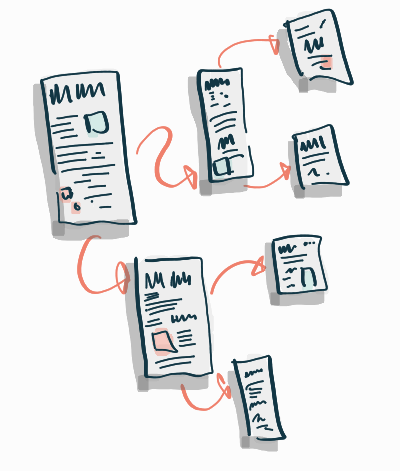
Quantity goes up and quality goes down. Companies can either produce a handful of amazing blog posts, or 100 shit ones.
Successful scaling requires tactical planning and systematic execution that retains the quality while increasing the volume.
The Importance of a Scaling Your Content Marketing
In the world of content, quality beats quantity. This is why a proper plan is critical before embarking on the scaling journey. A well-crafted strategy anchors the entire process, aligning it to the business goals, keeping it consumer-focused, and ensuring it’s enriched with value.
So why do we want so many blogs?
Because it get’s a shit load of traffic (I promise you, that’s the technical term).
This site here was a test for us earlier in 2023. In the space of three months we won nearly 200,000 clicks.
How?
283 content marketing blogs published. All by hand. To the tune of +$100k.
Yup, you read that right. It’s not cheap. No amount of great content is. Which is why the operations behind this are so important.
Content scaling strategy acts as a roadmap that guides oversight of the volume, the content mediums, the frequency of publishing, to the people responsible for ideation, creation, proofing, and publishing.
It also keeps a check on sticking to the brand values and language- an essential attribute in portraying a consistent brand image. Hence, a content scaling strategy is nothing less than a lifesaver amid the hustle to keep the content wheels rolling without running off the road.
Streamlining Your Content Creation Workflow: A Step-by-Step Guide
Key takeaways
- Process efficiency is the beating heart behind a successful content strategy.
- A well-oiled content creation workflow helps keep the quality up and stress levels down.
- Your journey towards an efficient workflow starts with identifying bottlenecks and ends with ongoing optimisation.
The Role of a Well-Defined Workflow in Content Marketing
For content marketers juggling tight schedules, a reliable and structured workflow is no less than a lifeboat in a sea of tasks.
Your content strategy ensures each piece goes through the required processes – from ideation to distribution – in a seamless, almost automatic manner.
Your workflow sets the rhythm, manages resources, and importantly, preserves your primary focus – quality.
Many companies still operate with broken workflows, often leading to uneven content quality, missed deadlines, and burnout. A content creation workflow plays a crucial role in preempting these issues, providing a roadmap for consistent, scalable content creation without compromising quality.
Steps to Streamline Your Content Creation Workflow
In this guide I’ll cover the three main areas of content scaling.
1. Setting the stage for making a lot of content.
2. How to make and publish all that content
3. Looking after all the content you just made
One. Setting the groundwork
I know you want to get things published today, but the problem with that is you have no processes. Yet.
In reality, you’re not scaling content. You’re creating Standard Operating Procedures to repeat the process of creating content. If your process is not repeatable, how do you expect to follow through with it day after day after day?
Getting the SOPs right is a huge task in and of itself.
There are a few things you’ll need to do before deciding to jump into the deep end of publishing a blog a day.
A checklist to follow, step by step, to build your content is one of the most important and helpful documents you will ever create.
That checklist will more than likely be filled with other checklists. That is totally fine.
Here are a few of the checklists I’ve built over my years of creating content strategies for clients.
- Keyword research
- How does your core audience use Google? Where do they get their information from?
- Mapping those keywords to a priority list and grouping them together
- Topic Order. My advice is to keep the topic the same for every X published to the site.
- It’s difficult for writers to keep jumping topics. I know it screws hard with me.
- It means content can go live with other supporting content in the same topic (topical authority anyone?)
- Means you’re filling out all the gaps in the topical map.
- Decide what minimum viable content (MVC) looks like to you.
- This is a term I learnt from the amazing Ben Goodey. Spend the time at the beginning to get everyone on the same page.
- What does MVC look like to you? What are the standards you stay firm on, and where will you reduce scope to keep the schedule on track?
- There are places where we can come back after publishing to make changes to content.
- Updating content
- When? 3, 6, 12 months after publishing?
- What will you update?
- How will you prioritise those updates?
Getting your SOPs in place is key. If you don’t, you will fail. A lot of these are covered in this guide, so keep reading to grab what you need.
Just by reading this you are doing 90% of step one.
Keep them simple, keep them up to date and keep them organised. You’ll win.
Two. Topics
Your site likely only needs 1-2 main topics for the whole site. At Penfriend we have three.
- Content Strategy
- Content Creation
- Content Research
You will notice how any of these could be sub-topics of the other two. That is by design. I want the overlap and to make it easy to create internal links between all three.
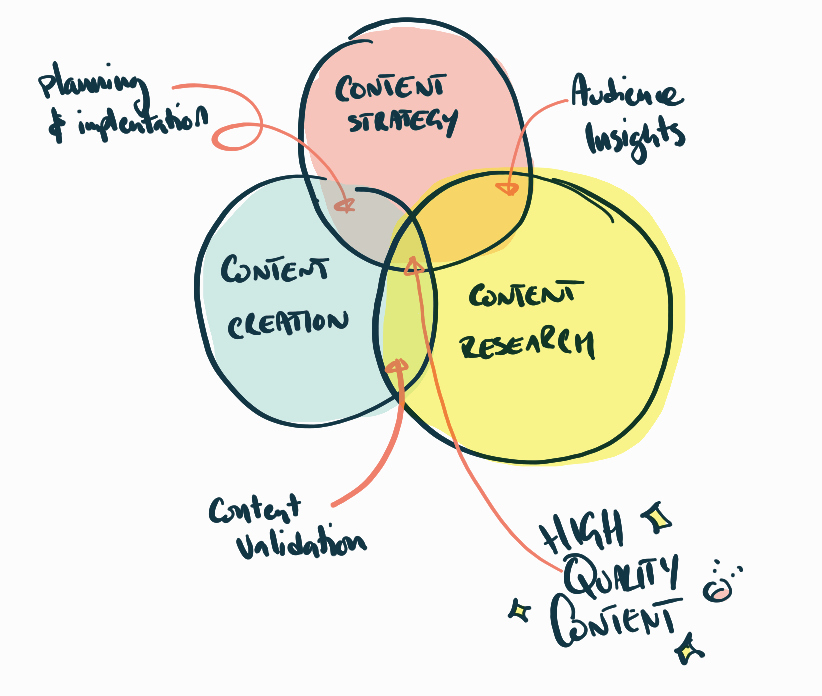
Each one of these could have many many sub-topics. A quick ChatGPT later and we have –
- Defining content strategy
- Content planning/creation (this is one of the other topics we already have)
- Distribution and promotion
- Analytics, reporting and measurement
- Management and governance
- Softwares
- Content for different business goals
- Content for specific industries and niches
- trends in content strategy
That’s just one prompt against one topic here. It’s worth thinking about where you want to play. Are you playing Bottom of Funnel and making content to help get people across the line with a purchase?
Or are you playing big, more middle/top of the funnel and going for a wider reach?
You can certainly do both. My advice is start with BoFu and move higher up over time.
Why? BoFu content at the beginning works great for sales enablement and for you to repurpose as more sales-like content on other platforms.
And then when you make your higher-up-the-funnel content, you already have somewhere to send those readers for them to further their reading. Bringing them closer and closer to the product/service you’re selling.
Three. Keywords
If you’re not writing all this content for ranking and organic purposes then, one, I’m questioning how you have so much time to waste. And two, how else are you getting eyes on this content?
Now you’ve come to your senses, we’re going to align all this content to keywords.
What keywords do I need for my topics?
Keywords are probably the hardest thing to work out. And for good reason. It’s a tough balance to find the right keywords for your own conversion, and for them to have enough search volume whilst not being too competitive (meaning you never rank…)
On top of this adding each keyword attempt can cost anywhere from $400 – $1,600. Those keywords suddenly have a lot riding on them. Like a lot a lot.
To add one more kick in the stomach, you WILL have to make content that, on paper, has little to no ROI. So you’re just throwing money at it for it to exist.
Why? Because topical authority is a thing. And you have to cover as much of it as possible. Don’t worry though, we can bring this cost down. And the ROI isn’t actually 0.
Choosing keywords
I like to pull all my keywords from 2 main sources, Ahrefs and Keyword Insights. There are plenty of other tools out there to use. These are the ones I know, so I’ll talk about them.
A quick note on if you don’t have any tools for this step. You’re going to find this very difficult. For you to come up with 100+ articles to write, you’ll likely need 5,000+ keywords to group together. And trust me, finding those keywords manually is a painful, time consuming process. Even if it’s just for a month, invest in the right tools and make the process easier for yourself.
Going over an entire keyword strategy is too much for this guide, for now I’ll give you a few formulas you can use to come up keywords that align to these stages.
Bottom of the Funnel (BoFu) Keywords
Definition: These are keywords used by potential customers who are ready to make a purchase or take a specific action. They typically have high purchase intent.
Example:
– If you’re selling digital marketing courses, BoFu keywords might be “buy project management software,” “project management tool free trial,” or “project management software pricing.”
Strategy:
1. Identify Product-Specific Keywords: Focus on keywords that are directly related to your product or service.
2. Include Transactional Phrases: Terms like “buy,” “purchase,” “price,” “discount,” or “deal.”
3. Use Brand Names: If your brand is well-known, include brand-specific keywords.
4. Long-Tail Keywords: These are more specific and often have less competition, great for high-ticket, low-volume legal and lab marketing strategies.
Formula:
[Product/Service] + [Transactional Term] + [Specific Attribute/Location (if applicable)] Middle of the Funnel (MoFu) Keywords
Definition: These keywords target users who are considering their options and looking for more information before making a decision. They have a research intent.
Example:
– For the same digital marketing courses, MoFu keywords could be “best project management tools,” “project management software comparison,” or “project management tool features.”
Strategy:
1. Focus on Informational and Comparative Keywords: Phrases that reflect the user’s research behavior.
2. Include Problem-Solving Phrases: Keywords that address specific challenges or questions users might have.
3. Educational Content: Terms related to guides, how-tos, and tutorials.
4. Use of Modifiers: Words like “best,” “top,” “comparison,” “reviews.”
Formula:
[Educational/Comparative Term] + [Product/Service Category] + [Specific Need/Question] Top of the Funnel (ToFu) Keywords
Definition: These are broad, general keywords that target users at the awareness stage. They are just beginning to recognize a need or problem and are seeking information.
Example:
– Using the digital marketing course scenario, ToFu keywords might be ““what is project management software”, “benefits of project management tools,” or “how to improve team collaboration.”
Strategy:
1. Broad and Educational Keywords: Focus on generic terms related to your industry or product, without the sales intent.
2. Address General Queries: Keywords that answer basic questions or introduce concepts.
3. Content Marketing Focus: Create valuable content like blog posts, infographics, and videos to target these keywords.
4. Avoid Sales Language: The aim is to inform and educate, not to sell directly.
Formula:
[Informative Term] + [Broad Industry/Product Category] + [Basic Query/Need] A quick summary
1. Understand User Intent: BoFu is about purchasing, MoFu is about researching and comparing and ToFu is awareness and initial understanding.
2. Use Keyword Research Tools: Use tools like google keyword planner, SEMrush, or Ahrefs to find keyword ideas and their search volumes.
3. Analyze Competitors: Look at what keywords your competitors are targeting.
4. Apply Formulas: Use the above formulas as a starting point, then refine based on your specific product/service and audience insights.
Use these to build out lots and lots of keywords and phrases. Then take that list and put them into keyword insights, or Ahrefs to find out the data behind them all.
Don’t worry if you get little data back. This is not a bad thing. It just means the tools don’t have data on them. I’ve seen many keywords in Ahrefs return a big fat 0 on the search volume. Only to see in search console we’re getting 1,000+ clicks a month to the same phrase.
Use the numbers as a litmus test, but trust your gut when it comes to the more problem focused keywords.
Four. Clustering/grouping + Prioritization
Now you have your list of pages to make, we’re going to want to group them together. There are many ways to do this, my favourite is with AI.
It doesn’t have to be perfect. There is no perfect. There is just “done”. And done means you know what groups of content you’re making and in what order they’re being made.
The groups matter because it means things go live with support. There’s nothing sadder than a blog going live with no internal links from other content. Maybe there is, but stick with me.
Content going live with support from other articles means it ranks faster, it holds those ranks better and it can be found from other articles. You’re not just relying on it ranking for it to be found.
How to group?

Take your list of keywords and put it into your AI of choice with this prompt. I’ve found this to be a great starting point to get things moving
“Adopt the role of a seasoned content strategist. Your job is to take a large list of keywords and group them together based on publish schedule and topical closeness.
Because it's better to publish content that can support it each, close together, we'll want to group content based on what makes sense to link together on the day it gets published.
Our focus is bottom of funnel content first pulling up into the middle over time, so then prioritise this list based on the most product forward content to be written first.
Group them together in batches of 5. So we can write one article a day per week.
The list of keywords are as follows.”I get a reply that looks like this
It’s not perfect, but it’s a start and helps push things in the right direction.
There are many tools that help with this process. I like Keyword Insights.
Five. Content Creation process
I’m going to use Penfriend for this, because it’s what we made Penfriend for. Great first drafts ready for your SME’s to add their points too, and with a quick edit you can get it on the site.
With Penfriend, the initial creation stage is the shortest stage. You should already have all your topics/articles mapped out, and the majority of the human-work comes in during the editing stage. Getting that great first draft is the key here to getting things moving.
How to choose the right keywords to put into Penfriend
Penfriend does the heavy lifting for you when it comes to understanding what ranks on the search results page (SERP). It’s built to look at your keyword and go see what’s ranking. It then takes these terms/titles/patterns that other sites use (the ones who are winning, #1-5) and use these to make your titles for the blog.
Best practice here is to put 3-6 words in the Penfriend box.
😔🤚 – how do I use a timer to get more work done in a short amount of time
😄👉 – how to increase personal productivity
The difference in the titles shows us how Penfriend is understanding the SERPs.
When we switch to the shorter phrase.
We have a pattern. It was easier for Penfriend to work out what the patterns is across titles and how to use that patterns to make a title that will rank.
This gives us a wide enough net to find the patterns, and enough data for Penfriend to see the gaps too.
If you go too narrow you’re painting Penfriend into a corner. It won’t have enough data on the SERP because the topic is so narrow that no patterns exist.
No patterns exist? What do you mean?
Well, Google estimates that roughly 15% of searches done daily, have never been done before. For a lot of searches Google will find the nearest search it has data on and use that to give you your results on the SERP. Penfriend relies on the patterns of established searches to give you the best chance of creating something that will gain traffic. We like traffic.
So, by pulling back just a little on your inputs you can give that content the biggest chance of ranking. And the nuances you wanted?
Add them to the content during the editing stage. Those nuances will help you rank even higher. Human first content is here to stay.
Once you have the article from Penfriend, you’ll want to edit it and get it on the site.
I want to do the writing process manually
Oh, ok. You’re more than welcome to. This isn’t something I’ll go into great depth about in this article, I’ll cover the basics of what you’ll need.
Having worked with many companies who have succeeded with content scaling with writers and editors, here are the basics of how this process works.
The roles you’ll need covered.
- Content Strategist
- For the majority of clients I work with, this is my role. I am responsible for
- Keyword/topic strategy
- Checking and getting the site in working order for all the content
- Priority of work
- Creation of content briefs/outlines
- Content Manager/Project Manager
- Gives the writers their work
- Major comms
- Sometimes their job to put content live onto the blog
- Writers
- The backbone of this work
- Researching the topics
- Creation of the content
- Makes the edits after feedback
- Editor
- Sense checks the content
- Suggests changes to content based on quality, focus, intent etc
- SEO
- Checks content to see if it fits SEO requirements
- Any level of site optimisation
People can play multiple roles in this sequence. BUT, it often becomes the bottleneck in consistent output.
People trying to outline and write an article in one day can hit content fatigue very quickly. I myself have hit that point numerous times writing this exact article.
The same goes with writing and then editing. I have learnt over and over (mostly from John Harrison) that writing and editing are two entirely different processes. They require a different headspace and have different goals. Trying to do both on the same day is incredibly taxing.
On top of this you’ll need SOPs for not only content creation, but passing the documents between parties.
I’ve seen end to end content processes have 20+ steps in them. Resulting in missed steps, and quality dropping after only a couple of weeks following the flow.
With Penfriend we cover, what I would consider, the chunkiest “leg work” tasks. Content outline/briefs, actual writing of the content and optimising for SEO. Meaning content can go from idea to published in one day, without burning out your writers/editors.
Six. Editing
As much as you wish you could, you do not want to publish articles straight from any AI tool. Yes, even ours. You will want to edit posts and make them YOURS in one way or another.
After 100’s of articles and many hours of conversation with writers, editors and other content strategists I’ve put together a 5 step process for editing AI articles. You can read the whole article over here, but as a quick overview you’ll want to follow this process.

Your voice –
The main reason we edit. Does it feel like you? Read like you? Add the human back into the content. Adding back in your own tone of voice. How do you write certain things, and talk about certain things etc.
Optimize –
Think about how you’ll be getting eyes on the content. If you’re creating to the extent we’re talking about here, your most likely channel for traffic is SEO. You’ll want to ensure you’re editing it to be found. Aligning it to search intent and providing great relevant next steps for the reader.
Update –
Check the facts, the numbers, the quotes, the stats. Using sites like Google’s own research database to back up the numbers in the blog. Check over any wild claims too. Can you back up “best/top/first of it’s kind”? If not, then remove.
Relatable –
Add your own experience here. Remember we’re a human talking to another human. Stories, first hand accounts, interviews with SME’s are your best friend here.
Strengthen –
Weak content is boring content. We make content strong via videos, images, quotes. Anything you can do to break up the content makes for stronger content.
Even when you have edited an article, it will still never be “right”. That’s ok. Learn to like this feeling. What is only 80% to you is likely 120% to someone else. And that last 20% for you? You can learn that by publishing and seeing how the market reacts. Where does Google place it? How many views are you getting? What are you ranking for?
This data will tell you so much more than trying to guess your way toward that last 20%.
Seven. Publishing
Publishing is the fun one. This where you’ll actually get the content on the site, ready for public viewing and then live.
This is where your minimum viable content checklist comes in handy. It can be easy to work an article to death. A bullet list here, another image there, no wait we have a video to go with it…..
Uh, just put it live and add it afterwards. My rule of thumb is to publish at 80-90% “readiness”.
That all being said, it still has to look good, and hit those standards to perform.
My personal on-page content checklist looks like this. Please take this and refine to suit your own standards and content needs. But, remember this checklist has been refined and made the way it is for a reason.
- Use 15px font at a minimum. Studies show that size 18-22px is best, but bare in mind that font size is literally the number factor to getting people to read your content
- More whitespace
- I said MORE whitespace. Add line breaks between more things. It’s ok.
- Include a number in the title
Use brackets in the title where possible
- User very short sentences in your intro.
- Limit the intro to 8 lines or less
- Add one subheader every 150 words
- Use emotionally compelling subheaders
- Toward the top of the article, use short (1-3 line) paragraphs
- Use first hand experiences before going to research things
- Add a LOT of images to your content
- screenshots
- charts
- diagrams
- product images
- before and after
- marked up screenshots. My favourite tool for this is Gyazo.com
- Use bucket brigades in your content. Essentially adding a question to the reader you’re immediately about to answer
- Keep the language to things people actually use. Do not sound like a corporate robot.
- DON’T BE BORING, have fun with it. Please no water is wet…
- Cite your data, research studies and facts.
- Include a strong CTA.
A good number of these will be covered during the editing process, but it’s nice to have a checklist to cross them all off whilst you’re giving it the once over before hitting publish.
A quick note on internal links
With all the content you’re producing, you should (Read: NEED) to be adding internal links to content.
If you’re creating an article a day, and keeping to the strategy of publishing in topic blocks, you should have a minimum of 5-8 supporting articles live when an article gets published. LINK THEM TOGETHER.
Internal links do what you think backlinks will do. They create trust. They link all the relevant articles together and you WILL win on the SERPs.
My goal is for each article to have 12 internal links pointing toward them.
There are many rules for placing internal links, but the two that answer 90% of all the questions I get are:
- Don’t add internal links in the first 150-200 words of an article. This is the introduction. It has a job to do. That job is keeping people on the page. NOT sending them somewhere else.
- One internal link per 200 words after that. This stops you from stuffing them everywhere and keeps the focus on the content people are reading.
Eight. Reporting
Reporting on content is a hugely important and equally difficult part of the process.
People absorb content in infinitely different ways. Bouncing around our perfectly crafted funnels. It’s a frustrating task to know how our prospects and users react to out content.
I am all for those people who want to map out every single step of the content journey, but I often find they get so caught up in the numbers that nothing gets done. The poster child for paralysis by analysis.
Yet on the other hand, those that don’t track have no idea if what they are doing is working.
My personal strategy over the last 10 years of seeing this all play out in front of me has been to take an overview of the situation and in key places push deeper.
My go to numbers to check have always been
- Total ranking keywords
- Target keywords ranking
- Total backlinks and referring domains
- Month-on-month traffic growth
- Month-on-month organic traffic growth
If these five metrics are trending up, you know you’re doing a good thing. And the easiest way to get them to trend up is to create more content.
There is a distinct connection between, more content ➡️ graphs go up.
I use Ahrefs to check these numbers, it’s nice to see them all in one place. You can track them in search console, with some difficulty.
These metrics only track that you content is performing it’s initial job well. Are you getting eyes on it? Will you get more eyes in the future? Is that traffic compounding?
These metrics DO NOT track the conversion performance of the content.
For this you’ll want to have a place for the reader to convert in the first place. It staggers me how often I have clients telling me their content doesn’t convert, and then they never actually put a button, sign up, anything in front of the reader for them to even convert on.
Now that you have a button, or signup, or newsletter for them to convert, you’ll want to track that. UTM’s are great, setting up goals in GA4 is a good place to start too. Also just seeing if your newsletter signups increase.
Nine. Looking after all your content
We have a full blog going over how to look after your content, what to check out and how to fix things over here – How to look after and update your existing content.
I’ll give you a quick run down of the main steps.
- Pull your analytics. Are things ranking for what they were written for? Are they slipping? How long is it taking to get to page 5, page 2, page 1?
- Check if the search intent is still aligned. What might you need to add to fix that?
- Update headings with the right topics and keywords
- Add more internal links from elsewhere on the site
Looking after what you’ve made is the most important step you’re overlooking.
I get it, it’s sexy and fun and new and exciting to write more content. To go after new keywords. To get a new audience.
That is exciting. Don’t get me wrong.
But, it goes against every fibre of what you’ve made to just let it exist and not do the job it was designed to do.
When you create this much content, there’s a belief behind it. You’re not just creating content, you’re building an asset. It’s an investment. To think otherwise is hugely short sighted.
I have seen huge increases in traffic and conversion just from looking after the already existing content.
The four states to update
You’ve pulled your analytics in the previous step so you will have a list of your pages and how they are performing.
Ranking well, getting traffic
These are the articles doing well. They rank for their target keywords and get a lot of eyes on them. For me once an article is getting 100+ visitors a week we want to change our goal from SEO increases to conversion increases.
Things like
- Adding CTA’s/signups/relevant next blogs
- Adding videos
- Create a content specific downloadable
- Potentially adding more context to the article
What you do not want to do is fundamentally change the concept of the content. Don’t switch huge things around. Don’t “fuck with it”. Just add to it.
Google has placed it high for a reason, and that reason is usually the “feel of the whole blog”. Don’t change that. Changing that more often than not results in you losing positions.
Pos 8-25
Content ranking here is on the right track, but needs a little something extra.
Often you’re missing search intent. Why are people searching what they’re searching for? Are you actually answering that question or just addressing it?
You’ll want to add things like
- Core keyword in the H1/H2’s. You’re likely missing it
- Shorter paragraphs and bullet lists to making skimming easier (improve readability)
- More internal links.
Pos 25+
Content ranking here is usually in one of two spaces. It’s either just been published in which case; do nothing. It’s not old enough for you to be making content decisions on it yet. OR it’s been live for a while and it’s stuck.
The most common reason why it’s stuck is it doesn’t match search at all. It’s not even close. Go and take a deeper look at the pages ranking for the keyword you’re going for. See what patterns they all follow.
How are they talking about the keyword/keyphrase you’re trying to rank for? More than likely you’re missing something obvious that 5+ pages on the SERPs are doing well.
The second most common reason why you’re not ranking? Likely word count. Check the average word count and make sure you’re matching that average.
Pos 50+
Rewrite. If you’ve been holding this position for your core keyword for 6-12 months. You likely need to rewrite the whole thing. This is a nobody page. As in, nobody is ever going to find it.
Ten. Refining the process
After the first three months of creation are over, have a meeting with the team to see how the process went. You’ll have this conversation more often than every quarter, but this is a call dedicated to just refining the process. Nothing else.
For you to hit 30, 40, 100 articles a month you will NEED to make these processes better over time. Little by little.
Cut the fluff. Merge them. Add new ones.
I cannot write something for every situation out there. This is however my starting point when designing this all for clients.
The more you scale, the more your processes have to be concrete.
For us, with Penfriend, the entire sequence looks like this.
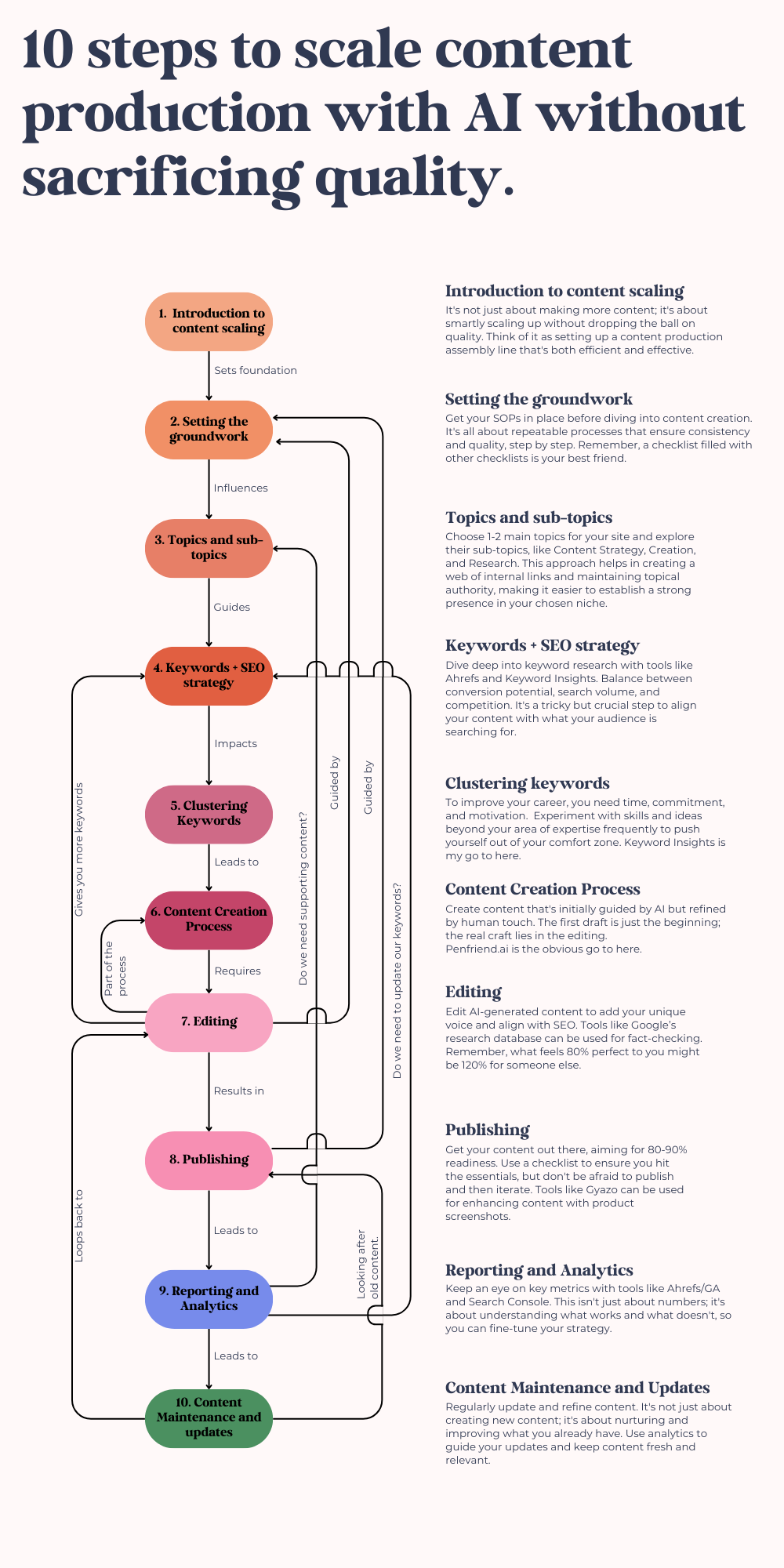
The tools to make this all work
Some of my favourite tools I’ve used over the years to make this whole thing easier.
I’ll start with the most obvious one, because it’s the site you’re on. Penfriend.
We were so annoyed with the tools that existed already that I HAD to make Penfriend.
Everything else was either shockingly bad, or required too much work to make anything happen. So Penfriend was born. And it’s taken a good number of sites from 0 blogs to 50 blogs in a matter of months.
Next is a place to manage all of this content creation. We use Coda.io . I’ve built an entire content strategy/production dashboard in Coda. I use it for clients. I use it for Penfriend.
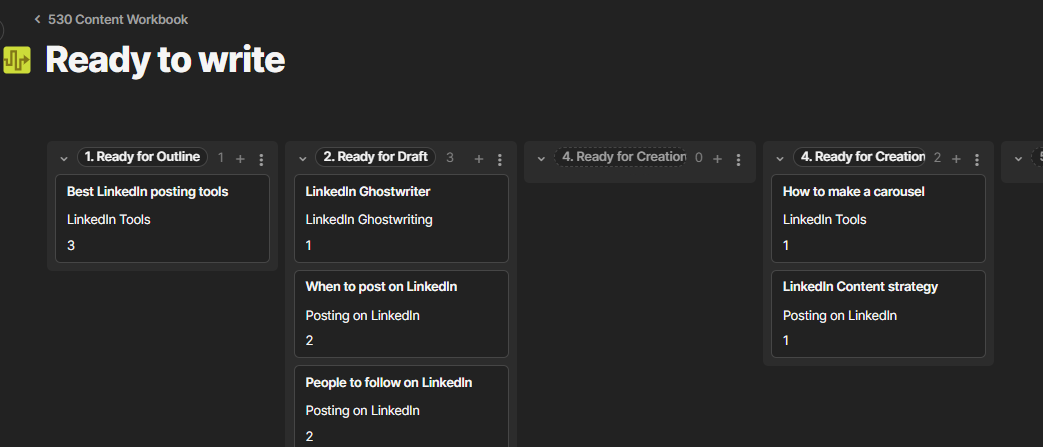
I never liked pre-built ones as I found them too rigid for the many differing needs of content production, not only across clients, but channels too. I like being able to build out the status, outlines and everything in one place. With you using Penfriend you won’t need the outlines, but the rest is so good to know too. Also automations make my life so much easier.

You could do something similar in Notion, ClickUp, AirTable etc.
My other favourite tools for this are
Ahrefs – Keyword research, tracking, competitor analysis, everything. I live in this tool. For a while it was my new tab page.
Surfer SEO – My understanding of onpage SEO just wouldn’t exist without Surfer. It makes it so easy to understand what I need to do on a page to hit topical relevancy and how tight the content needs to be for it to rank.
Miro – I use Miro to build out maps of the whole strategy in one place. I’ve found most content strategies fail because they exist in a spreadsheet and die. People don’t read them, they’re difficult to follow and no one can see at a glance what content they already have to support what they’re current working on.
I like to map out the site, see where everything sits and this gives me a much better idea of what’s to come and how we can use the content we already have.
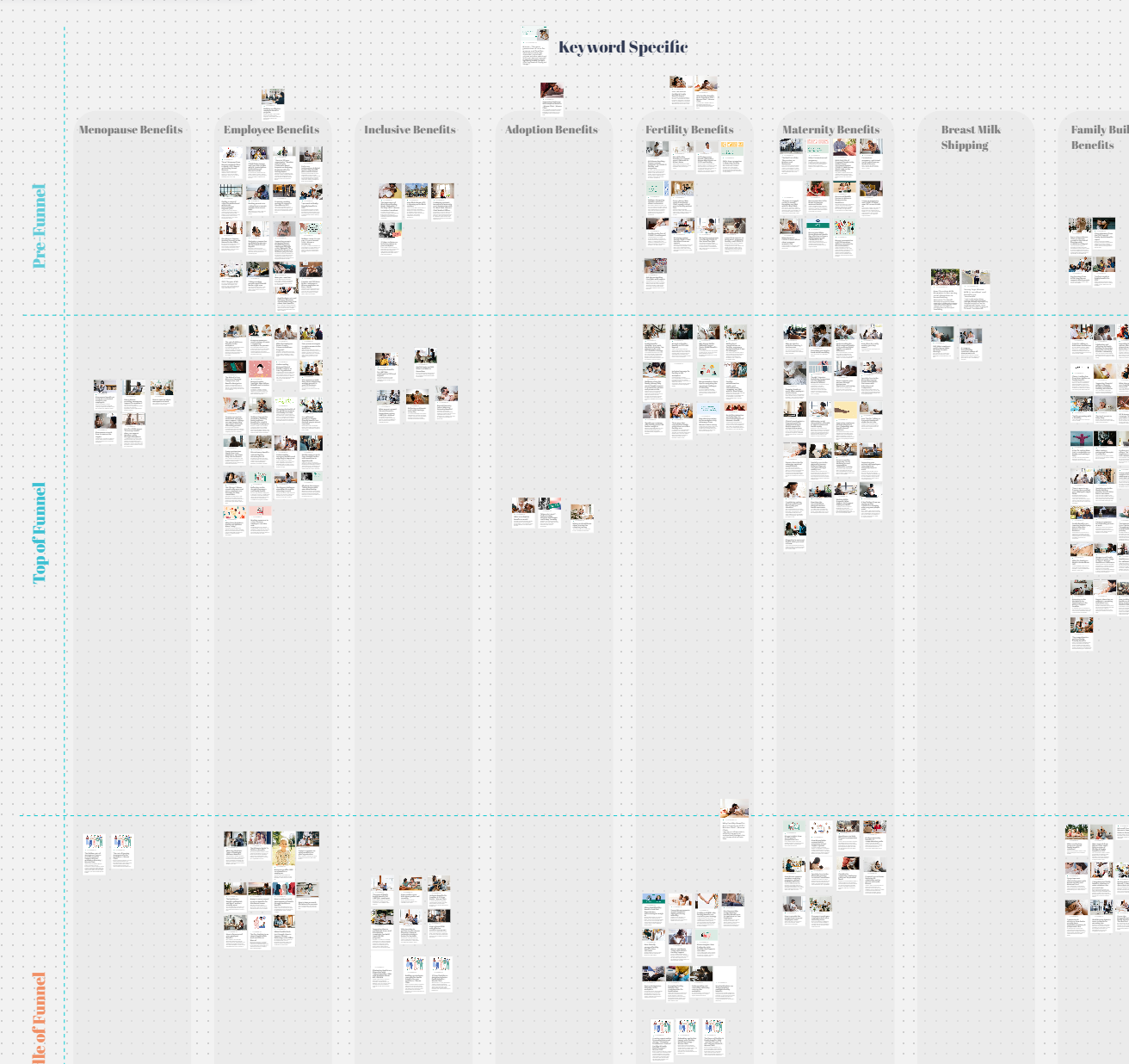
The problems you WILL have with this.
Identify Bottlenecks
Kick off by approaching your existing content creation workflow with an analytical lens. Find out where the jams are.
Often, these are the areas where tasks pile up, deadlines slip away and stress levels surge.
Before you put the time aside to start all the content creation, do you have a list of ALL the content you want to make on this sprint? Do you have a process to edit and upload all that content?
Define Roles and Responsibilities
Make sure every team member knows precisely what their role is and what is expected of them. This helps avoid overlapping tasks and miscommunication, eventually speeding up your workflow.
When task A is complete, how is it passed over to the next person for task B? The lack of process here WILL cause jams.
Use the right tools to make things faster
A smart workflow is an automated one. Content creation tools can take over repetitive, time-consuming tasks, freeing you up to concentrate more on strategic endeavours.
Audit and Refine Regularly
A streamlined workflow is not a final destination but a journey of constant refinement. Make it a habit to audit your workflow to identify areas for improvement.
Tips and Tricks for Maintaining an Efficient Workflow
Sustaining an efficient workflow is akin to maintaining a pro-level sports performance – it calls for discipline, consistency, and agility.
Embrace Flexibility
A rigid workflow is a recipe for disaster. Aim for a workflow that allows for last-minute changes or unexpected challenges without breaking.
Encourage Communication
Foster a cultural environment that welcomes ideas and feedback – it’s a catalyst for process improvement and can be beneficial for maintaining an effective workflow.
One Central Place of Truth
All the content, all the planning, all the current workflow. All of it, where possible, should live in one place. That way you can see at a glance what is going on, and who is working on what.
Stay Organized
An organized workspace, whether physical or digital, can significantly contribute to easing workflow management and improving overall productivity.
All said, streamlining content production revolves around a well-oiled workflow. By implementing these strategies, businesses can manage to keep up with the rapidly increasing demand for content and still maintain quality at all times. The next section will take you through the art of effective outsourcing in content production.
Heading Into the Fast Lane: Scaling Content with Quality in Mind
Scaling content production hinges on structured planning, consistency, a dedicated team, and leveraging the right tools. When attention is given to these aspects, the fear of compromised quality is put to rest.
Your turn – When are you going to embrace content scaling and adding a much needed 10-30 blogs to your site a month?
With the right process it’s much easier than you think.

